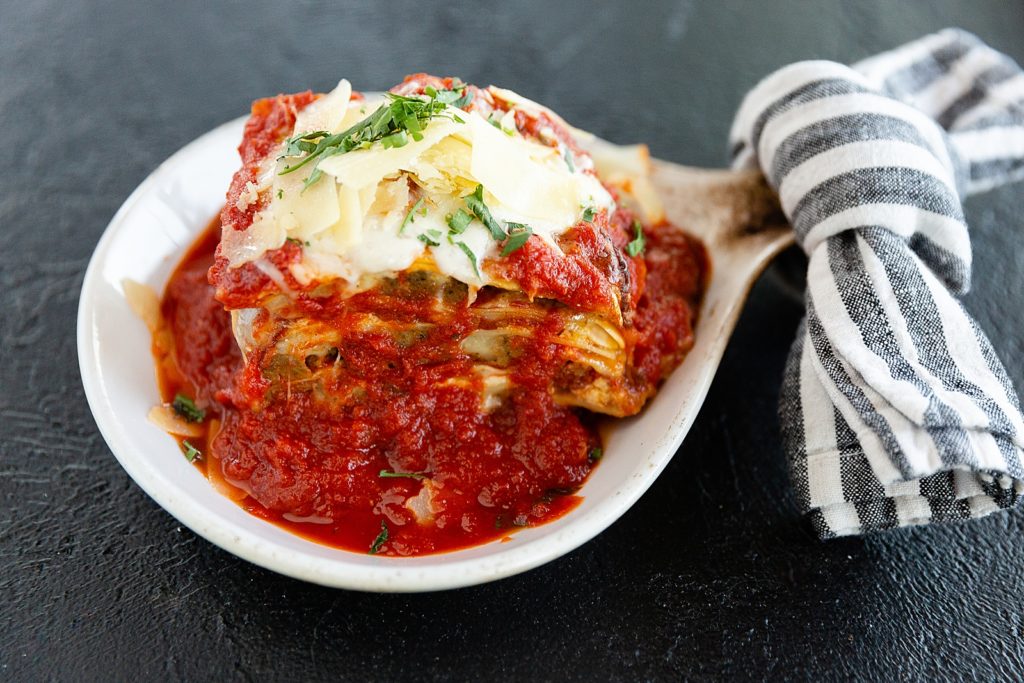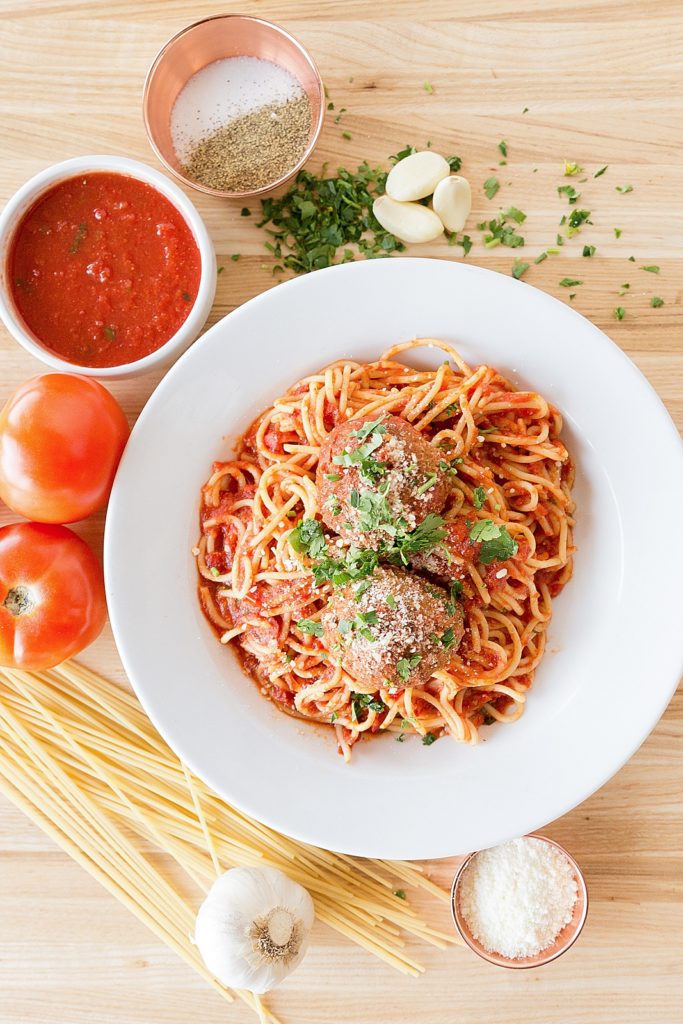Food photography quickly won its high place in our hearts for a couple of reasons. One reason is that one of our first real brand photography clients was a restaurant brand. We learned so much working with them and felt so blessed to develop friendships beyond the work experience with the family who ran the restaurant. Another reason for our love of food photography? It often results in a completed project that needs to be eaten! Can somebody say, ‘BONUUUUUUS!?’ Shooting food allows for so much creativity and offers a ton of opportunity to exercise different styling techniques unique to food alone. But one thing about food can cause a big pain point in the process if you aren’t prepared for it: Food Dies Quickly. Unlike other stationary objects you might photograph, food doesn’t stay looking beautiful and perfect for long. So how do you prepare for this inevitable truth? We’re happy to unpack our two tips for food photography for you today!
In Control of the Kitchen
We’ve photographed food for many different brands with many different goals in mind, but one thing is in common for all of them – the client wants the food to look mouth-watering and irresistible! When you work in a live restaurant environment, you have to tap into some different strategies as you don’t control the kitchen, but when you can control the kitchen, it’s a completely different game.
Some examples of times you might be in control of the kitchen would be shooting recipes for food blogs or if you are creating content for different phone apps that include recipes like we have with the Transform App. In these cases, you have control of the kitchen because you are the kitchen! This can equate to additional work since you are not only taking the photos of the final dish but also sourcing ingredients, cooking them according to the recipe, plating them and then photographing them. Extra work aside, the big upside to this set up is having complete control of the entire process.
So knowing that food dies quickly and starts looking ‘less than appetizing’ over time, how can you prevent that when you are in control of the kitchen? Our favorite tip – don’t really cook when you can avoid it. It sounds counterintuitive, but let us explain it for you.
When shooting for the Transform App, our goal is to show a final completed dish. We don’t need to show the creation process, so we just need a perfected final plate that draws the app user in and encourages them to create that recipe. In order to make the food look it’s best, we’ll often only sear off meats just enough to leave grill marks on the outside. Or we will toss asparagus in olive oil and spices and then heat it just enough to change the color before plating. These types of strategies give the appearance of an appetizing dish without running the risk of creating ingredients that are difficult to work with. Meat that is fully cooked can run the risk of overcooking or getting too ‘crispy’ on the outside. Fully cooked asparagus can become limp and impossible to style. If you do need to show the creation process, you can consider doubling the recipe – one to show the process and one to have picture-perfect for a final example.
To take that even one step further, think about things you might top your dish with and how they might respond differently to heat. For example, if that steak you are cooking is fully cooked and hot, the dollop of garlic butter scooped on top won’t last long for a photo opportunity. Instead, searing off the steak until the outside is perfectly brown with gorgeous grill marks makes it look good enough to eat, but cold enough to buy you more time with the garlic butter!
Here’s an example of a plate of lasagna we photographed when we had control of the kitchen. The inside of the lasagna was absolutely cold and the dish had been warmed just enough to melt the cheese inside. The resulting image looks so good, but trust us, you wouldn’t want to eat this one – unless you like ice-cold pasta!

Not in Control of the Kitchen
So that tip might be super helpful for you if you shoot recipes at home, but what if you are working in a restaurant and have zero control of how dishes are cooked? We’ve been here too and we have to admit – this situation does stretch your creativity, styling and photography skills, but it is so. much. fun. All of our sessions with Babbo Italian Eatery involved this same scenario and it challenged us to become more skilled and intentional in everything we did.
With Italian food, in particular, think about all of the ingredients that start looking less appetizing really quickly. Shredded or grated cheese on pasta melts almost instantly. Pasta sauce loses its thickness and can begin to separate and become watery. A perfect, mouthwatering slice of lasagna starts to droop and sag. So how do you style around a dish and take a photo when the ingredients break down so quickly?
While we couldn’t control the cook on the food, we could control the frequency with which the kitchen pumped out the dishes. If the kitchen was firing multiple dishes at once, we made sure that only one would have tendencies to break down quickly and that the others had a little more longevity. For example, if spaghetti and meatballs were being prepped and we knew that the sauce would start to get watery and the cheese topping would melt quickly, we’d have them prep a pizza and a salad at the same time because we knew the pizza would stay looking fresh for a few minutes and the salad even longer.
But let’s talk about that pesky plate of spaghetti and meatballs from this example. Even with the focus on working quickly only being on this one dish – how do you still work quickly enough to prep, style, and shoot the dish before it dies?
The answer is simple and one you hear from us a lot: Preparation.
For this client, we focused on showing the raw ingredients that made up the completed dish to reinforce their brand point of being a restaurant that only used fresh ingredients. That involves a lot of styling to accomplish! Knowing that a plate of spaghetti and meatballs would be coming out, we would ask the restaurant to start bringing out the raw ingredients before the final plate. We’d ask for uncooked noodles, a dish of the sauce, whole tomatoes, freshly chopped parsley, and whole garlic cloves. We would then use those ingredients to style everything out around can empty plate. This would involve imagining the final dish in that empty plate’s place and working backward, but the result would be a fully styled place for the final dish to set into and be photographed before breaking down.
That sounds a little daunting, but that’s why we said it challenged us to become more skilled and intentional in everything we did. Here’s an example of the image we actually created for them of the spaghetti and meatball plate we keep going on about!

Want to see a little bit more of the process in real life? Luckily for you, we’ve included a live video of Erica styling food in our Planning + Styling Course which will be dropping soon! Want to be in the know on the launch details and special offers? Sign up for the waitlist here.
And if you can’t wait for the course to launch for more insights into this topic, check out our behind the scenes video of shooting with one of our restaurant clients, Babbo Italian Eatery, here!
awesome tips guys… can’t wait to try my hand at some food photography!
Thanks, Colin, glad this was helpful information! Be sure to show us if you do!!
Dying waiting for that course! 🤣
Haha, we’re kinda dying over here too! It will be SOON! 🙂